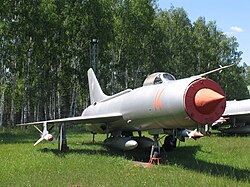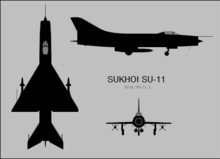Sukhoi Su-11
| Sukhoi Su-11 | |
|---|---|
 Su-11 in the Air Force Museum |
|
| Type: | Interceptor |
| Design country: | |
| Manufacturer: | |
| First flight: |
December 25, 1958 |
| Commissioning: |
1964 |
| Production time: |
1962 to 1965 |
| Number of pieces: |
108 |
The Sukhoi Su-11 ( Russian Сухой Су-11 , NATO code name : Fishpot-C ) was a Soviet interceptor from the 1960s.
development
The Su-11 is a modernized version of the Sukhoi Su-9 ( Fishpot ) with an improved engine, the new Oryol radar and modified armament. After extensive tests with new variants of the T-3 , designated PT-7, PT-8 and T-47 , the first flight of the prototype designated as T-47-8 took place in 1961.
During the development of the Su-11, the delta wings , the tail unit and the cigar-shaped fuselage were taken over from the Su-9. A key distinguishing feature compared to the previous model is the extended nose of the aircraft to accommodate the more powerful Oriol radar (NATO code name: Skip Spin ) and the addition of only two external load carriers. Furthermore, the more powerful Ljulka AL-7 F-1 jet engine with 98 kN and an improved afterburner was installed. Despite the heavier weight of the aircraft, the new engine brought better rates of climb and improved performance at high altitudes compared to the Su-9.
The armament of the Su-11 consisted of a pair of air-to-air missiles of the type R-98 (AA-3 Anab ), which bore the complex designation K-8, which mostly consisted of a radar-controlled R-98MR and an infrared-guided R-98MT composed. Like many interceptors of the time, the Su-11 did not have an on-board cannon.
The production of the Su-11 began in 1962 under the code name "Produkt 36", the serial machines delivered were called Su-11-8M (because of the armament with K-8M missiles). The first series machines were delivered in June 1962 and completed the factory trials in August. The crash of a machine during the troop testing caused the Soviet air force command, which was opposed to the pattern, to stop the entire program in favor of the Yak-28 P. Finally, a compromise was reached on a limited production of the Su-11 after appropriate modifications. Extensive tests were carried out again in 1963/64 and in May 1964 the first Su-11 were officially put into service. At the beginning of 1965, the last of a total of 108 built machines was delivered, a significantly smaller number than the predecessor model Su-9. In the design office itself, the Su-11 was sometimes seen as a dead end in development, and from 1960 worked on new designs for the T-49, T-5 and T-58, which ultimately resulted in the Su-15 . The Su-11s were soon supplemented or replaced by Su-15s, but some of them remained in service with the air defense regiments until the end of the 1970s.
Versions
- Su-11-8M : main variant
- Su-11U : two-seat training version with a smaller fuel tank
Military users
- 100 × Su-11-M8 "Fishpot-C"
- 8 × Su-11U "Maiden"
Technical specifications
| Parameter | Data from the Su-11-8M |
|---|---|
| crew | 1 |
| length | 18.29 m |
| span | 8.43 m |
| height | 4.88 m |
| Wing area | 34 m² |
| Empty mass | 9000 kg |
| Max. Takeoff mass | 13,600 kg |
| Engines | a Lyulka AL-7 F-1 with 99 kN with afterburner |
| Top speed | 1910 km / h |
| Service ceiling | 17,000 m |
| Range | 1125 km |
Armament
- Gun loading of 1000 kg at six external load stations
- Air-to-air guided missile
- 2 × PU-1-8 start rails for 1 × Bisnowat R-8MR (AA-3 "Anab") each - radar-controlled for medium -haul routes
- 2 × PU-1-8 start rails for 1 × Bisnowat R-8MT (AA-3 "Anab") each - infrared controlled for medium-haul routes
- External container
- 2 × UPK 23-250 containers, each with a 23 mm automatic cannon GRYAZEV-SHIPUNOV GSH-6-23 with 250 rounds of ammunition.
- 2 × drop-off additional tanks ZB-350 for 350 liters of kerosene
